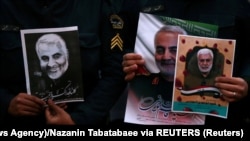Sentiments among Iranian social media users appear to be dramatically divided over the targeted killing of IRGC Qods Force Commander Qassem Soleimani. Most of the debate revolves around the variations in the characterization of the man and the way his life ended.
The debate is whether he was "the world's biggest terrorist" as President Donald Trump has said or "a national hero" and "an icon" as many Iranians, even some of the opponents of the Islamic Republic seem to believe.
Another aspect of the online debate is about whether he has been "Killed, martyred, or assassinated." Some Iranian Twitter users have been seen angrily attacking others who characterize the man as anything less than a martyr.
A BBC Persian journalist Kayvan Hosseini has observed in a tweet, "few Iranian figures have given way to such a divide among Iranians of various socio-economic classes and educational levels." He observed that the divide which existed before Soleimani's demise has now further deepened and turned into "serious prejudice."
Most of the debate has been taking place on Twitter while on other platforms including Instagram which is more popular in Iran than Twitter, there is very little about Soleimani.
Radio Farda analyst Morad Veisi wrote in a tweet that those with positive and negative attitudes toward Soleimani cannot tolerate each other's views and are blocking those with a different view in order not to see their posts and comments.
Apart from blocking. Trolls on both sides have been attacking those on the other side. Yasser Mirdamadi, an Iranian academic in the UK, has complained that trolls on both sides have attacked him, some for not specifying that Soleimani was "assassinated," and others because he had criticized those who cheered his death.
One Iranian Twitter user has listed around 70 Iranian celebrities who have paid tribute to Soleimani. The list is still being updated. Ironically, a user who writes under an alias like many others in and out of Iran fearing the government's occasional clampdown on social media activists, has scornfully labelled the celebrities as "those who have sold themselves and their country."
Although conflicting attitudes toward a single subject is a universal characteristic of Twitter all over the world, Golboo Fayazi regretted in a tweet that people on both sides of the spectrum used swear words while challenging each other.
In another development, Fatemeh Mahdiani wrote in a tweet that even Mehdi Karroubi, an Iranian political figure who has been under house arrest for nearly a decade for his opposition to Khamenei, has condoled everyone for Soleimani's death.
In the meantime, many on Twitter have been writing about the Stockholm Syndrome among Iranians who support figures such as Soleimani. By definition, the syndrome explains the situation of hostages that tend to sympathize with hostage takers.
On the other hand, others such as Hossein Mehrzad have written about the Washington Syndrome, in which the victims will support "any crime the United States commits" and try to justify it.
Others have challenged the idea that Soleimani was popular, attributing it more to organized propaganda than to genuine sympathy. Jalal Saeedi pointed out the prevalence of such propaganda and pointed out that during the 1979 Islamic revolution there was a well-engineered propaganda campaign that claimed Ayatollah Khomeini's face was visible on the moon.
Meanwhile, Radio Farda analyst Reza Haqiqatnezhad summed up some of the reasons for Soleimani's iconic imageamong some Iranians in a tweet on 3 January: "There has been a gigantic propaganda campaign ranging from the state TV to Friday prayers podiums, video clips, images on T-shirts, front-page pictures to comments by Foreign Minister Zarif and celebrated author Mahmoud Dolatabadi, and so on… to create the image of a superman, and a national hero out of Qassem Soleimani." He concluded that out of proportion reactions to his demise are not odd. "They are the result of all that work."







